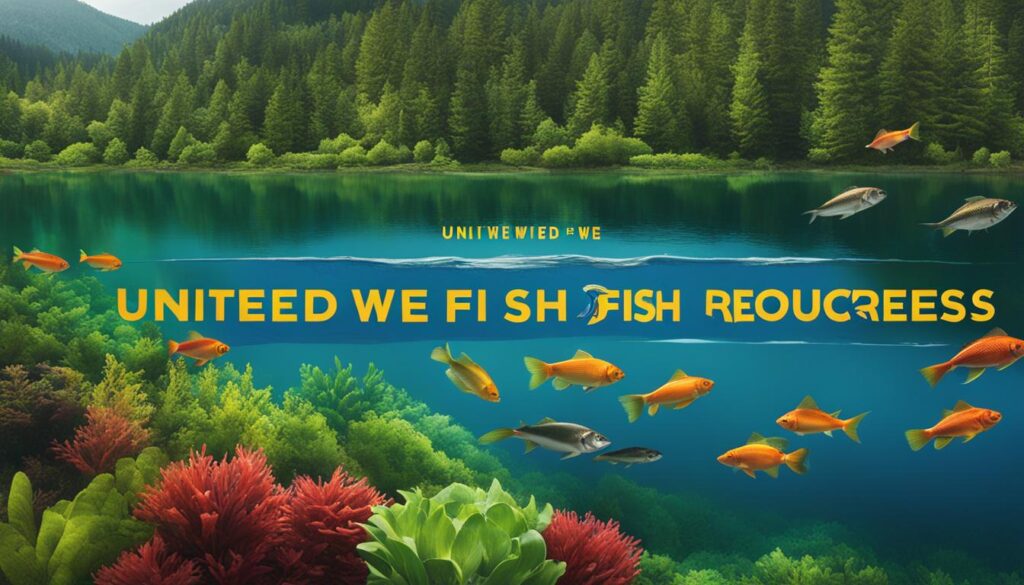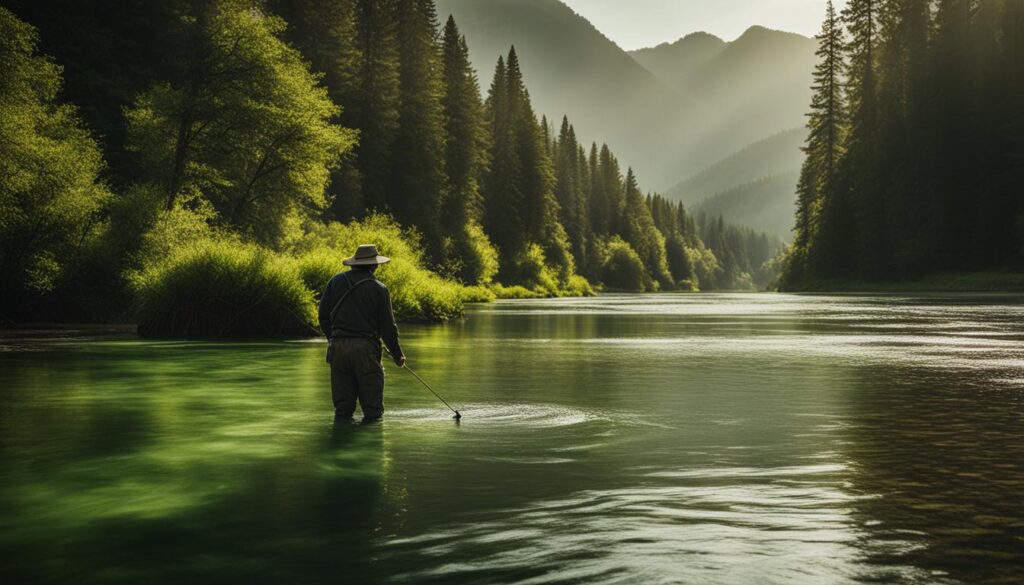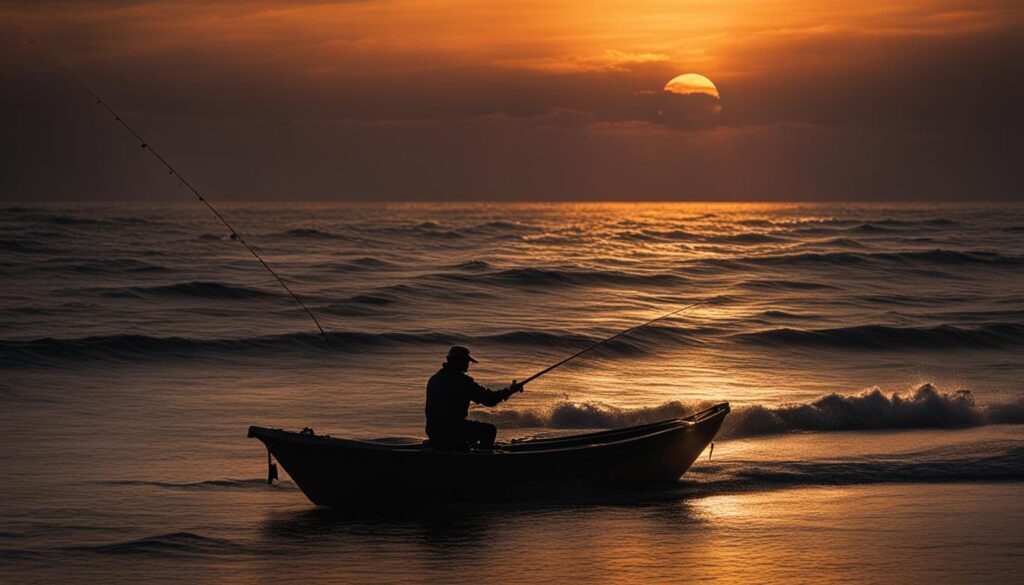We may earn money or products from the companies mentioned in this post.
Fishing has been an essential part of human civilization for centuries. It provides food and livelihood for people around the world. However, overfishing and unsustainable fishing practices are threatening fish populations and the ecosystems they inhabit. To ensure the longevity of fishing industries and preserve aquatic resources for future generations, fishing conservation efforts are crucial.
Sustainable fishing practices are the cornerstone of fishing conservation efforts. Catching fish in a way that does not harm the environment and allows populations to replenish is vital. Many organizations and initiatives are working towards promoting sustainable fishing practices to help restore fish populations and protect the environment.
In this essential guide, we will delve into the topic of fishing conservation efforts in the United States. We will explore the importance of sustainable fishing practices, fishery management, marine conservation and environmental impact, habitat restoration, and the role of fishing regulations. We will also highlight the collaborative efforts and initiatives undertaken to promote fishing conservation.
Key Takeaways:
- Sustainable fishing practices are essential to preserve aquatic resources and ensure the longevity of fishing industries.
- Fishery management and fishing regulations play a significant role in maintaining the sustainability of fish populations and ecosystems.
- Marine conservation efforts are essential to mitigate the negative impact of fishing on the environment.
- Habitat restoration is crucial in maintaining healthy fisheries and protecting biodiversity.
- Promoting sustainable fishing practices can benefit both fish populations and the economy of fishing industries.
Understanding Fishery Management
Fishery management is the process of regulating the fishing industry to ensure the sustainability of fish populations. The goal of fishery management is to prevent overfishing and to maintain healthy, productive ecosystems for the long-term benefit of both the environment and fishing communities.
Fishing regulations are a critical aspect of fishery management. These regulations vary depending on the location and species being fished, but they often include size limits, bag limits, and seasonal closures. The purpose of these regulations is to ensure that fish populations are not depleted beyond sustainable levels.
Fishery Management Councils
Fishery management councils are regional bodies established by the Magnuson-Stevens Fishery Conservation and Management Act. There are eight councils in the United States, responsible for managing fishery resources within their respective regions.
These councils are comprised of representatives from commercial and recreational fishing industries, environmental organizations, and government agencies. Together, they develop and implement fishery management plans, incorporating input from stakeholders and scientific research.
The Role of Scientific Research
Scientific research is critical to fishery management. It provides data on fish populations, ecosystems, and the impacts of fishing on these systems. This data is used to inform decisions on fishing regulations and management strategies.
Some examples of research methods used in fishery management include:
- Population surveys, which provide estimates of fish abundance and distribution
- Tagging studies, which track the movement and behavior of fish
- Ecological modeling, which allows scientists to predict the impacts of fishing on ecosystems
The Importance of Fishery Management
Fishery management is essential for the long-term sustainability of fish populations and the fishing industry. It ensures that fish populations are not depleted beyond sustainable levels and that ecosystems remain healthy and productive.
Effective fishery management also benefits fishing communities by creating economic stability and providing long-term opportunities for fishermen. By balancing the needs of the environment and the fishing industry, fishery management helps to ensure that both can prosper for generations to come.
Marine Conservation and Environmental Impact
The impact of fishing on marine environments cannot be underestimated. The continued degradation of our oceans spells catastrophic consequences for the earth’s ecosystem, economies, and communities. It is vital to promote marine conservation efforts to counter the negative impacts of unsustainable fishing practices.
Fishing, as an industry, is responsible for a significant proportion of marine pollution, habitat destruction, and depletion of fish stocks. The extraction of fish in unsustainable volumes leads to the imbalance in the ecosystem, affecting the survival of other aquatic life. In-conjunction with the effects of climate change accelerating across the globe, we must act now to mitigate the environmental impact of Fishing.
“The value of our marine ecosystems is critical to our planet’s health, food security, and economic growth. We must be forward-thinking and protective stewards of our oceans” – John Kerry
Marine conservation efforts are vital in combatting the environmental impact of fishing. These initiatives aim to promote sustainable fishing practices, enforce fishing regulations, and protect marine biodiversity. The establishment of Marine Protected Areas (MPAs) that restrict fishing activity and regulate human activities has proved successful in reducing the impact of fishing on marine environments.
An example of successful marine conservation efforts includes the Gulf of California Marine Program. This program has reduced the sidelining of non-targeted species by adopting fishing gear that is more selective for particular fish species. This has contributed to the recovery of several critically endangered marine species, including sharks and rays.
Initiatives like the Gulf of California Marine Program serve as an inspiration, highlighting the need for greater environmental awareness and the importance of collaborative efforts from all stakeholders to ensure the long-term preservation of marine ecosystems. They showcase that sustainable fishing practices do not only benefit the environment but also support the long-term economic viability of the fishing industry.
Habitat Restoration for Healthy Fisheries
Habitat restoration is a crucial aspect of preserving aquatic resources and maintaining healthy fisheries. It involves restoring degraded habitats and protecting intact ones, ensuring that fish populations have access to suitable breeding and feeding grounds.
Biodiversity preservation is a primary focus of habitat restoration efforts. By preserving and restoring aquatic habitats such as wetlands, estuaries, and coral reefs, we can protect the diverse range of species that call these habitats home.
“Habitat restoration is essential to ensure the long-term viability of fish populations and maintain healthy ecosystems. Restored habitats provide the foundation for healthy fisheries, which are vital to sustainable fishing practices.”
Habitat restoration projects can take various forms, including the removal of invasive species, the planting of native vegetation, and the construction of artificial reefs. For example, in the Chesapeake Bay, oyster reef restoration projects have been successful in improving water quality and enhancing the habitat for various fish species.
| Habitat Restoration Projects | Location | Impact |
|---|---|---|
| Oyster Reef Restoration | Chesapeake Bay | Improved water quality, enhanced habitat for fish species |
| Wetlands Restoration | Gulf of Mexico | Increased habitat for migratory bird species and improved water quality |
| Coral Reef Restoration | Florida Keys | Enhanced habitat for fish species and increased tourism revenue |
In addition to supporting biodiversity, habitat restoration also provides various ecosystem services, including erosion control, water filtration, and nutrient cycling. These services are crucial to maintaining the health and resilience of aquatic ecosystems and supporting the livelihoods of fishing communities.
Overall, habitat restoration is a critical tool for preserving aquatic resources and promoting sustainable fishing practices. By restoring and protecting habitats, we can ensure the long-term health of fish populations and ecosystems, and support the economic and social well-being of fishing communities.
Sustainable Fisheries and Catch and Release Practices
As we’ve discussed, sustainable fishing practices are essential for the long-term health and viability of fish populations and the fishing industry as a whole. One such practice is catch and release, which involves catching fish and then safely releasing them back into the water.
Catch and release is particularly important for endangered or threatened species, as it allows them to reproduce and rebuild their populations. It also helps maintain a healthy balance in the ecosystem by preventing overfishing and reducing the number of fish that are taken out of the water.
Another benefit of catch and release is that it can actually improve the overall quality of fishing. By allowing fish to grow and reproduce, we are ensuring that there will be more and larger fish available for future generations of anglers to catch.
However, it’s important to note that catch and release practices must be done correctly to minimize harm to the fish. Using proper equipment, handling the fish gently, and releasing them quickly and carefully can help ensure their survival.
Overall, promoting sustainable fisheries through practices such as catch and release is crucial for preserving fish populations and the fishing industry for years to come.
The Role of Fishing Regulations in Conservation
Fishing regulations play a crucial role in the conservation of fish populations and their ecosystems. By setting limits on the amount and size of fish that can be harvested, fishing regulations help ensure that fish populations are not overexploited. This, in turn, helps maintain healthy ecosystems and promotes sustainable fishing practices.
Environmental impact assessments are often conducted to determine the potential effects of fishing activities on marine ecosystems. These assessments use data such as fish population levels, habitats, and ecological interactions to inform fishing regulations. The regulations can then be tailored to specific environments and fish populations to minimize the impact of fishing on the ecosystem.
Types of Fishing Regulations
There are several types of fishing regulations that can be implemented to protect fish populations and their habitats:
- Size limits: These regulations specify the minimum or maximum size of fish that can be harvested. By allowing smaller fish to reach maturity and reproduce, size limits help maintain healthy fish populations.
- Bag limits: Bag limits restrict the number of fish that can be harvested per person per day. This helps prevent overfishing and ensures that fish populations have time to recover.
- Fishing gear restrictions: Certain types of fishing gear can have a negative impact on fish populations and their habitats. Regulations on the type of gear that can be used can help minimize these impacts.
- Seasonal closures: Temporarily closing fishing areas during specific times of the year can help protect vulnerable fish populations during critical life stages, such as spawning.
The Importance of Effective Fishing Regulations
Effective fishing regulations not only protect fish populations and their ecosystems but also benefit the fishing industry and the larger economy. Sustainable fishing practices ensure that fish populations remain abundant, making fishing a viable and profitable industry for years to come.
“Fishing regulations are a key component in maintaining the balance between economic development and environmental conservation.”
By preventing overfishing and allowing for the regeneration of fish populations, fishing regulations safeguard the health of ecosystems and ensure the preservation of biodiversity. This is critical not only for the survival of fish populations but also for the entire food chain and the countless species that depend on healthy marine ecosystems.
Overall, fishing regulations play a crucial role in conservation efforts, helping to make fishing a sustainable industry and ensuring the continued health of our oceans and freshwater habitats.
Collaborative Efforts and Initiatives
The United States has made significant strides in fishing conservation efforts, due in large part to the collaborative efforts and initiatives of various organizations, government agencies, and individuals.
One such example is the partnership between the National Marine Fisheries Service (NMFS) and the Atlantic States Marine Fisheries Commission (ASMFC). Together, they have implemented measures to rebuild depleted fish stocks, such as the black sea bass fishery in the Mid-Atlantic region.
Additionally, the National Fish Habitat Partnership (NFHP) has worked with state and federal agencies, non-governmental organizations, and the private sector to restore and conserve aquatic habitats across the country. Their efforts have resulted in significant improvements to water quality, fish populations, and biodiversity.
Furthermore, the establishment of marine protected areas (MPAs) has been a crucial step in preserving marine ecosystems and promoting sustainable fishing practices. The National Oceanic and Atmospheric Administration (NOAA) has worked with local communities to establish MPAs such as the Flower Garden Banks National Marine Sanctuary in the Gulf of Mexico.
The Marine Stewardship Council (MSC) is another organization that has made significant contributions to fishing conservation efforts. They have developed a certification program for sustainable fisheries, which helps consumers make informed choices and encourages businesses to adopt sustainable practices.
Overall, these collaborative efforts and initiatives demonstrate the importance of working together towards a common goal of sustainable fishing and marine conservation. By pooling resources and expertise, we can ensure the long-term health and productivity of our oceans and aquatic resources for generations to come.
Conclusion
In conclusion, fishing conservation efforts are crucial for ensuring the sustainability of our aquatic resources. Without sustainable fishing practices, fish populations and ecosystems can become severely depleted, leading to significant environmental and economic consequences.
It is essential to continue promoting sustainable fishing practices and support organizations and initiatives dedicated to fishing conservation. By doing so, we can ensure the continued abundance of fish species, preserve biodiversity, and maintain the economic stability of fishing industries.
Overall, sustainable fishing is not just a responsibility but a necessity. It is up to all of us to take action and make a positive impact on our planet’s aquatic resources.
Let’s work together to protect our oceans and fisheries!
FAQ
What are fishing conservation efforts?
Fishing conservation efforts refer to initiatives and actions taken to protect and preserve aquatic resources, promote sustainable fishing practices, and ensure the long-term health and abundance of fish populations and their habitats.
Why are sustainable fishing practices important?
Sustainable fishing practices are important to maintain the ecological balance of marine ecosystems, prevent overfishing and depletion of fish populations, and safeguard the economic viability of fishing industries for future generations.
What is fishery management?
Fishery management is the process of regulating and controlling fishing activities to ensure the sustainable use of fishery resources. It involves setting fishing regulations, monitoring fish populations, and implementing measures to protect vulnerable species and habitats.
How does fishing impact the environment?
Fishing can have various environmental impacts, including habitat degradation, bycatch of non-target species, and disruption of marine ecosystems. Unsustainable fishing practices can lead to decreased biodiversity, ecosystem imbalance, and overall environmental degradation.
What is habitat restoration, and why is it important for fisheries?
Habitat restoration involves activities aimed at improving and restoring aquatic habitats that have been damaged or degraded due to human activities. It is crucial for fisheries as healthy habitats provide essential breeding grounds, shelter, and food sources for fish, contributing to their overall population and vitality.
Why is catch and release important for sustainable fishing?
Catch and release is an important practice in sustainable fishing as it involves releasing caught fish back into the water unharmed. It helps conserve fish populations, particularly for species with low reproduction rates, and allows fishermen to enjoy the sport while minimizing the impact on fish populations.
What is the role of fishing regulations in conservation?
Fishing regulations play a critical role in conservation efforts by establishing rules and guidelines for fishing activities. They help prevent overfishing, protect vulnerable species and habitats, and promote sustainable fishing practices to ensure the long-term health and viability of fisheries.
What collaborative efforts and initiatives exist for fishing conservation?
Various organizations, government agencies, and individuals collaborate on fishing conservation efforts. These collaborations include partnerships to develop sustainable fishing practices, the establishment of marine protected areas, educational campaigns to raise awareness, and scientific research to inform conservation strategies.
Affiliate Disclosure: This post may contain affiliate links. If you purchase through our link, we may receive a small commission, but at no additional cost to you. For more information, please see our Disclosure statement.



